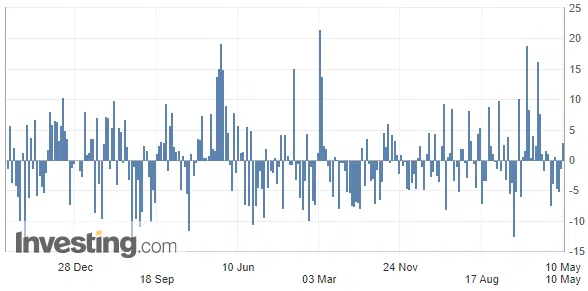Written by: Sebastien Bischeri
Does the unexpected rise in weekly crude oil inventories herald a further fall in demand?
The commercial crude oil stocks rose unexpectedly last week in the United States, as imports fell less than exports, according to figures released Wednesday by the U.S. Energy Information Administration (EIA).
U.S. Crude Oil Inventories
Indeed, during the week ended May 5, US commercial inventories swelled by 2.951 million barrels while analysts expected a decline of 0.917 million barrels:


Overall, crude oil inventories amounted to 462.6 million barrels, which remains 1% lower than the average of the last five years.
U.S. Gasoline Inventories
On the other hand, gasoline stocks fell by 3.168 million barrels following an increase in demand (+685,000 barrels per day), whilst a decline of 1.233 million was expected:


An important point to make is that the government also dipped slightly into the U.S. strategic petroleum reserves (SPR), which fell by almost 3 million barrels to 362 million barrels.
Regarding refinery activity, a slight acceleration was noticed, with operations running at 91% of capacity compared to 90.7% the previous week.
In brief:
- Crude exports almost halved last week (nearly 2 million barrels per day less), which partly explains the increase in reserves.
- Imports remained strong even if they fell to a lesser extent (by almost 0.850 million bpd).
- U.S. crude production remained stable well above 12 million bpd.
- Demand for petroleum products increased by almost 0.360 million barrels per day, bringing it to over 20 million.
- Gasoline demand, as the busy car travel season approaches, has inflated by 685,000 bpd to reach 9.3 million bpd.
Banking Crisis
The authorities and players in the banking sector hoped that the takeover of First Republic by JPMorgan on Monday would sound, at least temporarily, the end of the turmoil in the world of finance, but regional banks remained under pressure on Wall Street.
This is why the shares of regional banks took a hit amid contagion fears.
Macroeconomics
On the macroeconomic side, a stricter monetary policy could weigh on the world's largest economy by increasing the cost of credit for households and businesses.
This would increase the risks of recession and, therefore, of a drop in demand for oil, as crude oil is probably one of the most sensitive assets to recession fears.

(Credit: StockCats)
China
In addition, some negative signals about China's economic growth add to general apprehensions about the global economy, with a contraction observed in April for the purchasing managers' activity index (PMI) in China, reflecting the health of the industrial world.
Technical Charts

Energy Futures (Continuous: current contract in front, daily charts)


